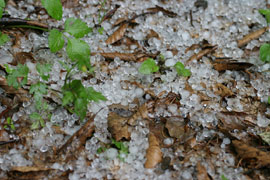Where Does Hail Come From?
Ouch, that hurts. Hail is just frozen raindrops, but they can range in size from a small pea to a grapefruit.

Weather Wisdom: Hail
Where does hail come from? The sky, of course! Seriously, how is hail formed, and why is it relatively rare? Hail is generated in a thunderstorm, and is really just frozen raindrops. A thunderstorm contains winds that blow rapidly downwards (a downdraft) and rapidly upwards (an updraft). Raindrops inside a developing thunderstorm are carried aloft by updrafts. While the lower part of a thunderhead contains warm air, at altitudes above 25,000 feet, air temperatures are always below freezing (32°F). Water droplets at such high altitudes freeze, a process called “riming” or “icing”.
Since most thunderheads can grow to 40 or even 50 thousand feet in height, it is possible for raindrops to be caught in an updraft and quick-frozen into hail. A piece of ice can be tossed up and down several times, melting partially and refreezing, before finally becoming heavy enough to fall through the violent updrafts to the ground. Once a drop has frozen, other drops can freeze to it, creating an ever-larger hailstone.
If you’re ever in a hailstorm, wait until it’s over and collect a few of the stones. Cut one in half and look for layers or lines around the center drop. The presence of these mean that the original raindrop made several trips up and down the thunderhead “elevator” before breaking through to the ground.
Hailstorms are most frequent in eastern Wyoming, eastern Colorado, and western Nebraska. In warmer climates such as Florida, where thunderstorms are frequent, you will rarely see hail. Why not? Because hail will fall through a warm, moist layer of air at the bottom of the thunderstorm, causing it to melt before it reaches the ground.
Hailstones can range in size from a small pea to a grapefruit. The largest hailstone ever measured fell at Coffeyville, Kansas on September 3, 1970. It had a circumference of 17.5 inches and weighed 1.671 pounds. Ouch!
This article was published by the staff at Farmers' Almanac. Do you have a question or an idea for an article? Contact us!






